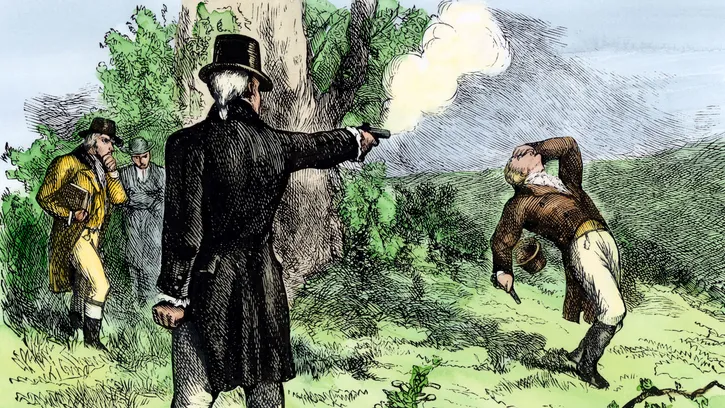On the early morning of July 11, 1804, the skies over Manhattan began to brighten, and a small boat quietly made its way across the Hudson River to the shores of New Jersey. Onboard were two notable figures of the time: Aaron Burr, the sitting Vice President of the United States, and his close friend, William Van Ness. They landed in Weehawken, New Jersey, a location that would soon become infamous in American history. After disembarking, they made their way to a small clearing, where Van Ness cleared some rocks and branches from the ground. A short time later, another boat arrived, carrying three men: Alexander Hamilton, the former Secretary of the Treasury and leader of the Federalist Party; his friend Nathaniel Pendleton; and Dr. David Hosack.

The stage was set. The players were Aaron Burr and Alexander Hamilton, with Van Ness and Pendleton as their seconds. The scene was about to unfold: a duel.
A duel wasn’t a new concept in the early 19th century. While it may seem shocking that two of the most influential figures in American politics would resolve their differences through such an act, dueling had been a common practice among military officers and gentlemen of the time. It was seen as a way to defend one’s honor and courage. Dueling was a tradition deeply ingrained in the culture, especially among men like Burr and Hamilton, both of whom were military veterans.
As expected, the two men stood ten paces apart. Upon Pendleton’s command, the two raised their pistols and fired. The first shot rang out, and Hamilton fell, gravely wounded. The next day, he died, at the age of 49.
The duel between Burr and Hamilton is often regarded by historians as one of the most dramatic moments in early American political history. It was a moment of reckoning that involved two of the most prominent figures in the founding of the United States. As historian Henry Adams put it, it was a “most dramatic scene” in the nation’s early political history. What led to this tragic encounter? Was it simply a personal feud, or were there deeper political conflicts at play?
The Roots of the Conflict
To understand how two former allies turned into bitter enemies, we must go back to the late 18th century. Both Burr and Hamilton had once been close collaborators. During the American Revolutionary War, they fought alongside each other, serving as officers in the Continental Army. Over time, their shared experiences forged a strong bond. However, the political arena soon tested their relationship.
In 1791, Burr ran for the U.S. Senate and defeated Hamilton’s father-in-law, Philip Schuyler, which was seen as a personal betrayal by Hamilton. Burr’s sudden shift in political alliances, moving from a moderate Federalist stance to a more centrist approach, upset Hamilton greatly. Hamilton viewed Burr as untrustworthy and opportunistic, while Burr saw Hamilton as a man driven by lofty ideals, willing to betray his friends for political gain.
This political rivalry intensified during the 1800 presidential election. Burr had been Jefferson’s running mate, but the election results led to an unexpected tie between Burr and Jefferson. In the deadlock that followed, Burr’s refusal to step aside for Jefferson, despite earlier promises, caused a fracture in their relationship. Hamilton, always distrustful of Burr’s ambitions, intervened by rallying support for Jefferson in the House of Representatives, ultimately securing Jefferson’s victory. Burr’s ambition and the perceived betrayal left him deeply resentful of Hamilton.
The Duel: A Reflection of Political and Social Norms
By 1804, the use of rifled guns made dueling more dangerous, yet it still remained a method for gentlemen to settle their disputes. Both Burr and Hamilton had a military background, which made the idea of a duel somewhat expected. Yet, dueling was not universally accepted, and many of the Founding Fathers, including George Washington and Thomas Jefferson, strongly opposed it. Benjamin Franklin even equated dueling with “premeditated murder.” Despite their opposition, dueling was still prevalent among military men, as it was seen as an essential way to protect one’s honor.
The duel between Burr and Hamilton was not just a personal matter. It symbolized the broader political conflicts of the era. Burr’s actions were often viewed as self-serving, while Hamilton’s idealism made him a target for those who opposed his vision of America’s future. In a time when political power was often decided by reputation, duels like this were a way for men to defend their honor in a world where the stakes were high.
The Aftermath and the Cultural Legacy
Following Hamilton’s death, Burr’s political career faced serious challenges. Though he served as Vice President under Thomas Jefferson, he lost much of his political clout after the duel. Jefferson, who had once been allied with Burr, distanced himself from him following the 1800 election and the fallout from Hamilton’s death. Burr’s ambitions to become Governor of New York and even President of the United States were thwarted, largely due to his tarnished reputation.
The cultural impact of the duel was profound. It marked the end of an era where dueling was considered a legitimate way to settle disputes, especially in American politics. It also signaled the growing divide between personal ambition and the pursuit of ideals in American leadership. The duel is often remembered as a tragic moment in the country’s early history, illustrating the dangers of unchecked ambition and the high price of honor in the volatile political environment of the time.
Today, the legacy of the Burr-Hamilton duel serves as a reminder of the intensity of political rivalry in early America. While dueling may no longer be a common practice, the underlying themes of ambition, honor, and political rivalry remain relevant. Political conflicts today, though often more civilized, still carry the same weight of personal and professional stakes that were present in the early days of the United States.

No comments yet.